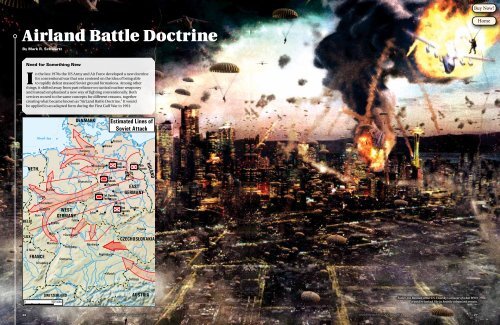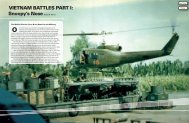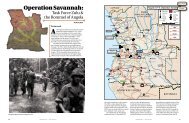Airland Battle Doctrine - Modern War Magazine
Airland Battle Doctrine - Modern War Magazine
Airland Battle Doctrine - Modern War Magazine
Create successful ePaper yourself
Turn your PDF publications into a flip-book with our unique Google optimized e-Paper software.
Buy Now!<br />
<strong>Airland</strong> <strong>Battle</strong> <strong>Doctrine</strong><br />
By Mark R. Schwartz<br />
Home<br />
Need for Something New<br />
I<br />
n the late 1970s the US Army and Air Force developed a new doctrine<br />
for conventional war that was centered on the idea of being able<br />
to rapidly defeat massed Soviet ground formations. Among other<br />
things, it shifted away from past reliance on tactical nuclear weaponry<br />
and instead emphasized a new way of fighting conventionally. Both<br />
services moved to the same concepts for different reasons, together<br />
creating what became known as “AirLand <strong>Battle</strong> <strong>Doctrine</strong>.” It would<br />
be applied in an adapted form during the First Gulf <strong>War</strong> in 1991.<br />
Soviet-era Russian artist V.S. Visotsky’s concept of what WW3<br />
would’ve looked like in heavily urbanized terrain.<br />
26 MODERN WAR 6 | JUL–AUG 2013<br />
MODERN WAR 6 | JUL–AUG 2013 27
A formation of Soviet tanks moves out.<br />
Throughout the Cold <strong>War</strong>, Soviet<br />
and their <strong>War</strong>saw Pact allied armed<br />
forces lacked the training and<br />
technologically advanced weaponry of<br />
the North Atlantic Treaty Organization<br />
(NATO). Rather, their advantage lay<br />
in their ability to concentrate large<br />
numbers of armor, artillery and<br />
mechanized infantry divisions for<br />
what were expected to be decisive<br />
battles and exploitation deep into<br />
Western Europe. Soviet doctrine<br />
called for “deep operations,” using<br />
densely massed armies and air forces.<br />
American military planners doubted<br />
the ability of then current NATO<br />
doctrine to stop such an offensive<br />
without the employment of tactical<br />
nuclear weapons. That was something<br />
that would devastate Europe, regardless<br />
of who “won” any such future war.<br />
Of course, the Soviet system<br />
wasn’t infallible. Its tactics were<br />
relatively inflexible; its units formed<br />
9 miles 9 miles<br />
up in predictable echelons, and its<br />
technology was inferior. Further, the<br />
<strong>War</strong>saw Pact command and control<br />
(C2) system was overly centralized.<br />
Plans were made at the upper level,<br />
with higher headquarters retaining<br />
control of all aspects of operational<br />
execution down to the tactical level.<br />
At the same time, Soviet doctrine<br />
called for units to seize the initiative<br />
and conduct complex, mobile operations.<br />
Thus those centrally controlled<br />
tactics would likely falter if an opponent<br />
could disrupt their execution.<br />
For example, Soviet doctrine called<br />
for second and third echelon forces<br />
to move through and exploit breakthroughs<br />
made by the first echelon.<br />
Those two echelons weren’t flexible<br />
reserves; rather, they were rigidly slated<br />
as to when and where to move as part<br />
of the larger overall plan. Hence, were<br />
the initial phase of the offensive to<br />
be disrupted, US strategists expected<br />
56 miles<br />
the rest of the operation would also<br />
fall apart. The dilemma, then, was in<br />
having forces prepared to fight largescale<br />
mobile battles, actions that went<br />
well beyond simply holding a line.<br />
Until the 1970s the US Army<br />
doctrine for conventional warfare was<br />
called “Active Defense.” It stressed firepower<br />
over maneuver, and its central<br />
idea was to attrit attacking forces to the<br />
point they halted their advance. Then<br />
reserves would be committed to push<br />
them back. The doctrine was unimaginative,<br />
but it seemed to be the best<br />
alternative in the face of Soviet and<br />
<strong>War</strong>saw Pact numerical superiority.<br />
The US experience in the Vietnam<br />
<strong>War</strong> indicated attritional tactics were<br />
unable to gain a decision, at least in<br />
a politically acceptable timeframe<br />
and with politically acceptable losses.<br />
Rather than fighting outnumbered<br />
and winning, the new concept that<br />
emerged was aimed at controlling<br />
the larger “battle space” in order to<br />
reduce the strength and effectiveness<br />
of enemy forces prior to the moment<br />
of main contact between opposing<br />
ground forces. That called for interdicting<br />
the adversary’s flow of men, materiel<br />
and supplies using aerial assets,<br />
long-range artillery, and airmobility.<br />
By immediately taking the fight<br />
deep into the enemy’s rear area, NATO<br />
could channel the attackers’ movement,<br />
open gaps among their formations,<br />
and block follow-on echelons<br />
from joining the battle. All that would<br />
then result in the disruption of their<br />
momentum and combat effectiveness.<br />
That, in turn, would force a “culminating<br />
battle” in which NATO could<br />
maneuver to decisively counterattack<br />
whatever had by then been identified<br />
as the enemy center of gravity,<br />
thereby gaining the final decision.<br />
Extended <strong>Battle</strong>field<br />
AirLand <strong>Battle</strong> had four doctrinal<br />
tenets: initiative, depth, agility and synchronization.<br />
To execute those tenets,<br />
the corps was to become the primary<br />
C2 headquarters, both utilizing divisions<br />
in operational-level engagements<br />
and also conducting the deeper fight,<br />
the latter by synchronizing organic<br />
artillery assets with air power.<br />
Corps were to attack enemy<br />
formations massing for combat up<br />
to 100 miles away. The overall battle<br />
space was partitioned into the Close<br />
<strong>Battle</strong> Area (up to 13 miles beyond<br />
the Forward Line of Own Troops or<br />
FLOT), the Deep <strong>Battle</strong> Area (which<br />
might extend to 120 or more miles<br />
beyond the FLOT), and the even more<br />
distant Strategic <strong>Battle</strong> Area, in which<br />
operations were reserved for airpower.<br />
Maneuver-unit commanders<br />
operated within an “area of interest.”<br />
Maneuver brigades at the FLOT<br />
generally influenced the battle to a<br />
depth of nine to 13 miles, while the<br />
divisions did so out to 43 miles. In<br />
comparison, Soviet doctrine placed<br />
follow-on maneuver formations in<br />
reserve at 18 to 30 miles from the<br />
FLOT. Thus the US would actually be<br />
fighting far deeper than would the<br />
“deep operations” of the Soviets.<br />
Commanders were to plan to<br />
fight within their areas of interest<br />
as determined not only by higher<br />
headquarters’ guidance, but also by<br />
their own appreciation of the enemy’s<br />
actual and anticipated actions. That<br />
area of interest concept was another<br />
new dimension of AirLand <strong>Battle</strong>: they<br />
were to overlap between adjacent<br />
maneuver units, so more than one<br />
could be coordinated to concentrate<br />
attacks against the same enemy force.<br />
As a result the battlefield became<br />
increasingly non-linear, and the<br />
importance assigned to an enemy<br />
formation didn’t necessarily match its<br />
relative distance from the FLOT. All of<br />
that demanded speed and initiative,<br />
in order to be able to strike enemy<br />
units deep in their own rear area as<br />
opportunities presented themselves.<br />
As stated in Field Manual (FM) 100-5,<br />
Operations: “Operations must be rapid,<br />
unpredictable, violent, and disorienting<br />
to the enemy.” The overarching<br />
intent was to avoid engaging head on<br />
the enemy’s main strength by first,<br />
disrupting his fighting capabilities<br />
and then shattering his will to fight.<br />
Jointness<br />
The new army doctrine was<br />
aligned with close air support (CAS)<br />
concepts the air force wanted to<br />
apply to its own evolving concept of<br />
deep battle. The air force had always<br />
resisted the reduction of airpower<br />
to the mere status of flying artillery,<br />
preferring instead to operate against<br />
strategic and other targets beyond the<br />
battlefield. Nonetheless, a working<br />
partnership with the army came into<br />
place in forging the new doctrine.<br />
above — The TRADOC ensignia.<br />
right — Gen. William Dupuy.<br />
TRADOC: The US Army’s Intellectual Side<br />
Douglas Skinner, a noted military analyst, described doctrine as “a level of<br />
abstraction and generality higher than strategy. <strong>Doctrine</strong> is a guide to thought on how<br />
to employ strategy and tactics. Commanders formulate their strategy, employ tactics,<br />
then appeal to doctrine for how to combine these elements effectively in battle.”<br />
In the 1950s and 1960s, US Army and Air Force doctrine for a future war in Europe<br />
revolved around nuclear weapons. Both services intended to use them liberally against<br />
attacking Soviet and <strong>War</strong>saw Pact forces. Additionally, the army intended to disperse its<br />
formations across the battlefield to deny lucrative targets for Soviet nuclear weapons.<br />
Neglect of conventional war-fighting doctrine during Vietnam left an intellectual<br />
vacuum as Soviet military power grew and technological innovations made their impact<br />
felt. The 1973 Yom Kippur <strong>War</strong> demonstrated the power of anti-tank guided missiles,<br />
suggesting massed enemy armor could be stopped. To bridge the doctrinal gap, the army<br />
formed its Training and <strong>Doctrine</strong> Command (TRADOC) in 1973 under Gen. William Dupuy.<br />
TRADOC developed doctrine for the army, becoming the intellectual engine for all<br />
such developments. TRADOC’s new look at land warfare determined armored warfare<br />
was feasible in Europe while conflicts elsewhere would involve mostly light infantry.<br />
Dupuy counseled NATO weaponry could provide victory in initial European battles,<br />
but formations would have to be concentrated. TRADOC evolved “Active Defense”<br />
as a first – but transitory – doctrinal effort. The next TRADOC commander, Gen. Don<br />
Starry, expanded that thinking in his 1978 <strong>Battle</strong>field Development Plan. That advocated<br />
attacks against enemy second echelon forces. Better force management techniques<br />
were also developed, as did viewing the “extended battlefield” as a dimension of time<br />
as well as distance. Under Starry, TRADOC made AirLand <strong>Battle</strong> ready for war. b<br />
The USAF Tactical Air Command<br />
(TAC), alongside the army’s Training<br />
and <strong>Doctrine</strong> Command (TRADOC),<br />
formed the Air-Land Forces<br />
Applications Agency (ALFA) and the<br />
Joint Studies Group (JSG) in 1977.<br />
ALFA tested the new A-10 CAS aircraft<br />
and attack helicopters, producing<br />
joint tactics to focus air-delivered<br />
weapons against tactical targets.<br />
JSG also investigated methods to<br />
interdict <strong>War</strong>saw Pact second-echelon<br />
formations: each headquarters<br />
would have USAF tactical air control<br />
parties (TACP) to identify targets to<br />
be engaged by fixed-wing aircraft.<br />
Before submitting requests for that<br />
kind of help, ground unit commanders<br />
had to check if organic artillery could<br />
do the job. If so, the mission went<br />
to those assets. Air support requests<br />
endorsed by the corps headquarters<br />
went to the theater-level C2 center to<br />
be matched with available aircraft.<br />
ALFA and JSG grouped Combat Air<br />
Support (CAS) and Air Interdiction (AI)<br />
to form a new mission area, Offensive<br />
Air Support (OAS), applying fixed-wing<br />
attack to the ground battle. Artillery<br />
would also be used to suppress hostile<br />
air defense systems threatening OAS<br />
missions, thereby supporting airpower.<br />
28 MODERN WAR 6 | JUL–AUG 2013 MODERN WAR 6 | JUL–AUG 2013 29
Buy Now!<br />
Col. John Boyd & the OODA Loop<br />
In his 1976 briefing, Patterns of Conflict, Col. John Boyd – a<br />
USAF fighter pilot and doctrinal theorist – proposed a new set<br />
of tactics with no set front line, utilizing hit-and-run attacks<br />
against Soviet maneuver groups. He advocated a “deep battle”<br />
that would be fought in the Soviet rear area as well as via agile<br />
maneuver along the front. Its objective was to derail the <strong>War</strong>saw<br />
Pact command system. Boyd asked the following questions.<br />
Why try to reduce your own friction and uncertainty? Why<br />
not magnify the adversary’s friction and uncertainty?<br />
Why try to exhaust the adversary by increasing his efforts? Why<br />
not paralyze him by denying opportunities to expend effort?<br />
Why strike at one center of gravity where mass<br />
is concentrated? Why not strike at many smaller<br />
centers of gravity that sustain the larger system?<br />
He suggested traditional strategists erred by viewing conflict<br />
from the top down. He emphasized adaptability by pushing decisions<br />
to lower levels as the battle tempo increased. He advocated<br />
a coherent command and control (C2) structure by synchronizing all<br />
levels of command. Missions were to be contracts between superiors,<br />
who dictated what must be accomplished, and subordinates<br />
who served their superiors’ intent with imagination and initiative.<br />
Boyd also coined the term “OODA Loop.” That was the<br />
decision-making process of: Observe, Orient, Decide and Act. The<br />
idea was to operate inside the adversary’s OODA time-cycle by<br />
performing all of its elements faster, thereby controlling every<br />
level of conflict. That idea applied equally to overall ground<br />
force commanders and individual fighter pilots and everyone<br />
in between. Today that concept is advocated by most military<br />
schools of thought as well as many business strategists. b<br />
CAS vs. AI vs. BAI<br />
Like the US, NATO saw the corps as the spearhead<br />
of deep operations. It developed a new fixed-wing<br />
OAS mission, <strong>Battle</strong>field Air Interdiction (BAI), to<br />
attack enemy follow-on echelons. The US in turn<br />
accepted BAI as part of its doctrine in 1979, but<br />
the US Air Force said it should be a weapon of the<br />
theater-level air component commander (ACC) rather<br />
than any ground force corps. BAI thus became a focal<br />
point for army vs. air force AirLand <strong>Battle</strong> debate.<br />
CAS supported close battle and required detailed<br />
integration with small-unit maneuver and fire plans,<br />
and safety measures were needed to protect ground<br />
troops from friendly fire. CAS could attack no deeper<br />
than the fire support coordination line (FSCL), a control<br />
measure giving the ground force commander authority<br />
over air strikes to the range of his organic artillery<br />
(usually out to 12 miles beyond the FLOT). The commander’s<br />
TACP proposed likely CAS missions inside<br />
the FSCL, and he approved or denied those proposals.<br />
CAS thus remained a secure part of AirLand <strong>Battle</strong>,<br />
but the question remained as to how enemy second<br />
echelon forces moving toward friendly troops already<br />
engaged against first echelon units could be struck.<br />
By mid-1981 air force and army staffs had endorsed<br />
an agreement that set up OAS apportionment and<br />
allocation procedures, and directed that corps<br />
commanders would select BAI targets. Theater-level<br />
C2 allocated sorties to OAS missions with army-level<br />
advice on their distribution to corps and divisions.<br />
To integrate CAS with his unit’s scheme of<br />
maneuver and fire, each commander required<br />
timely information on the location of enemy and<br />
friendly formations. That level of situational awareness<br />
remained hard to achieve for brigade and<br />
division commanders in fluid situations. Generally<br />
only the corps possessed information adequate to<br />
decide if a CAS request was better served by organic<br />
artillery fire or needed higher-level commitment.<br />
According to the 1981 inter-service agreement, BAI<br />
would engage enemy concentrations of sufficient size<br />
and importance to have a potentially decisive effect<br />
on the overall land battle. BAI would therefore target<br />
only battalions or larger formations, especially those<br />
spearheading an attack and the units following them to<br />
exploit penetrations. In 1981 the USAF high command<br />
declared that agreement to constitute official doctrine.<br />
Further Debate<br />
The 1982 edition of FM 100-5 officially premiered<br />
AirLand <strong>Battle</strong> and defined BAI as the “primary means<br />
of fighting the deep battle at extended ranges. BAI<br />
isolates enemy forces by preventing their reinforcement<br />
and resupply and by restricting their maneuver.<br />
It also destroys, delays, or disrupts follow-on enemy<br />
units before they can enter the close battle.”<br />
The army intended to diminish <strong>War</strong>saw Pact superiority<br />
along the FLOT by destroying follow-on reinforcements.<br />
AirLand <strong>Battle</strong> still omitted guidance on<br />
resolving overlaps or gray areas between CAS and BAI.<br />
For instance, one question was:<br />
should BAI be used at the point<br />
of penetration? The figure above<br />
illustrates that dilemma, with a Soviet<br />
thrust approaching friendly lines and<br />
in CAS range. CAS could attack the<br />
flanks of the thrust, but the enemy<br />
could still shift troops laterally in<br />
their mid- to deep-zones to position<br />
for a breakthrough or exploit one.<br />
One proposal was that targets<br />
beyond the FSCL be made solely<br />
a USAF responsibility, especially if<br />
dispersed across more than a onecorps<br />
area of interest. That then led<br />
to lobbying for centralized control<br />
of massed air assets, to be matched<br />
by decentralized mission executions<br />
by the tactical air control parties.<br />
That, in turn, would effectively have<br />
put BAI into command limbo.<br />
The army then further complicated<br />
matters with its deployment of longerrange<br />
weapons. Corps could augment<br />
division fires with the Multiple Launch<br />
Rocket System (MLRS), which could<br />
hit targets up to 18 miles within the<br />
Deep <strong>Battle</strong> Zone. The Army Tactical<br />
Missile System (ATACMS) offered a<br />
range of up to 186 miles. Likewise,<br />
Apache attack helicopters could<br />
range out to 62 miles into that zone.<br />
In 1985 it was suggested the FSCL<br />
be kept close to the FLOT, no more<br />
than 9.3 miles deep. That aligned with<br />
the limits of observed fire (out to about<br />
three miles from friendly positions)<br />
and troop safety needs. The idea was<br />
the more controlled circumstances<br />
inside the FSCL permitted BAI to target<br />
leading elements of the enemy second<br />
echelon. Failure to accept those procedures<br />
would create a “No-Mission”<br />
zone within the FSCL, where neither<br />
CAS nor BAI met the criteria for use.<br />
In 1986 the army revised AirLand<br />
<strong>Battle</strong> to synchronize ground operations<br />
with larger theater and campaign<br />
objectives, dictating that air-to-ground<br />
operations support campaign objectives<br />
rather than be subordinate to<br />
the needs of individual battles within<br />
it. The proving ground for all that<br />
theorizing would finally come in 1991.<br />
<strong>War</strong> in the Gulf<br />
In response to the Iraqi conquest<br />
of Kuwait in 1990, the US committed<br />
sizable land and air forces to fight<br />
in the 1991 operation codenamed<br />
Desert Storm, a.k.a. the First Gulf<br />
<strong>War</strong>. That fighting exposed doctrinal<br />
3 miles<br />
19 miles<br />
40 to 70 miles<br />
rifts that still divided soldiers and<br />
airmen. While the ground force<br />
commander lamented the effective<br />
absence of BAI, the airmen applied<br />
CAS across all the deep battle space<br />
nominally given to BAI, irrespective<br />
of FSCL placement. Doctrinal support<br />
for division-level deep battle<br />
evaporated. <strong>Battle</strong>field air interdiction<br />
was controlled and executed by the<br />
air commander as part of his larger<br />
theater-level air interdiction campaign.<br />
The air force regulated their strikes<br />
through their method of planning and<br />
executing the air war – Air Tasking<br />
Orders (ATO). The ATO scheduled<br />
air missions with inputs from all<br />
interested targeting agencies and<br />
placed air assets accordingly. It operated<br />
on a 72-hour cycle paralleling the<br />
corps planning cycle of 72 to 96 hours.<br />
There was a continuous evaluating of<br />
intelligence against missions proposed<br />
for every 24-hour period, and it was<br />
resolved by using the best mix of<br />
missions. That system, controlled at<br />
the theater air commander level, misaligned<br />
with the 24 to 72 hour planning<br />
and execution cycle at division-level.<br />
It thereby effectively legislated BAI<br />
operations out of the division’s reach.<br />
Doctrinal expectations for a<br />
European conflict evaporated with<br />
the realities of the war in the Persian<br />
Gulf. CAS remained available for<br />
the close battle, but the absence of<br />
Home<br />
30 MODERN WAR 6 | JUL–AUG 2013 MODERN WAR 6 | JUL–AUG 2013 31






